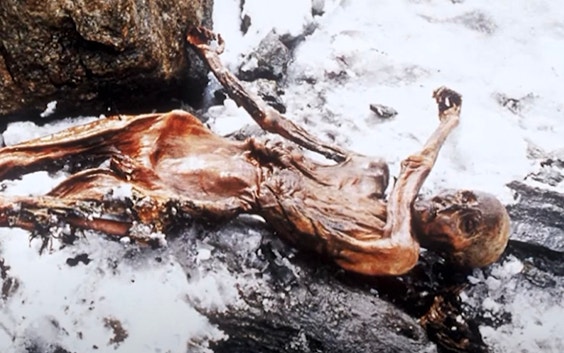CUSTOMER STORY
Behind the Scenes: The Workflow of the Engineer Who Recreated Ötzi in 3D

After years of lobbying, the DNA Learning Center in Cold Spring Harbor, New York, finally gained permission to recreate the world’s only 3D copy of Ötzi, the mummified ‘Iceman’ discovered in the Tyrolean Alps by a pair of hikers in 1991. Renowned paleo artist Gary Staab reached out to Materialise to make the project a reality, and worked closely with Eric Renteria, our very own application engineer. Here is a detailed report of how he recreated a life-sized model of the world-famous Iceman.
The First Steps
Gary Staab had previously collaborated with Materialise to 3D print a replica of King Tut, giving audiences worldwide the chance to see what the ancient pharaoh looked like underneath his wrappings. In collaboration with the DNA Learning Center, Gary received the CT scans of the Iceman’s body, in order to recreate the fragile artifact.
The Materialise Approach
Application Engineer Eric Renteria back at Materialise was given the fascinating, and at times daunting, task of converting the body in 3D.
Although he had learnt from his previous experience on the King Tut project that it was essential to receive a complete scan of the entire specimen, the CT scans of Ötzi the iceman came in multiple sections. And most daunting of all: it was only when Eric was trying to put the separate scans back together that he found out there were some slices which were missing.
As rescanning Ötzi wasn’t an option, and optical scanning would cause too much of a threat to the fragile body, Eric had to improvise and rethink his workflow.
Filling in the Blanks
First of all, Eric uploaded the data sets in the Materialise Mimics software and then filled in the masks to create initial solid parts from each scan. He used the aligning tools in Materialise 3-matic to position the pieces correctly. In order to do this, Eric used an image he received from Gary which included the actual measurements of the real Ötzi, and he translated and rotated the pieces using the distances and angles apparent on the image. Then came the real challenge: designing the missing part. Of the 2827 image slices which eventually constituted Ötzi’s finished virtual 3D model, the gap accounted for approximately 86. There was a chunk of Ötzi’s ribs missing, and also part of his arm. As these pieces were not planar, it was necessary to use a tool which would enable Eric to create curved, more organic lines, which would fit naturally within the body’s shape. The tool which saved the day was the Sweep Loft tool, in 3-matic, which allows the user to identify certain contours on the parts. Using those curves in space, it starts at one contour and follows along the curve, allowing the user to interpolate along the middle space.
Eric started his task by mirroring part of Ötzi’s ribs to fill in the piece that was missing on the left side, and also cut the added ribs to be planar along with the rest of the gap. He added a sketch in-between the gap, and projected the contours of the top and bottom piece. The gap in the arm was filled as well and the final result was an accurate, organic model of Ötzi’s body.
The final step of the process was hollowing out the design whilst retaining its structural integrity; the last thing everyone wanted was for the model to break during shipping, or while Gary applied his artistry. The production team supplied the specifications, and Eric hollowed out the model according to their expertise.
That’s when Ötzi was ready to rise again, this time from the liquid resin which fills the Mammoth Stereolithography printers at Materialise. Occupying a build area of more than two meters, these printers are able to print large components which don’t need assembling or gluing, and their speedy patented curtain recoating technology ensured that Ötzi would be on his way to Gary Staab’s studio as soon as possible.
In Eric’s words, “I had a great amount of fun working on the Ötzi project. I felt like a digital archeologist when I uncovered some of the issues with the scan and I was excited to use my extensive software knowledge to find solutions – I was literally engineering on anatomy.”
Looking to the Future
The potential for 3D Printing to impact research and education is huge. It presents new opportunities for archeologists and paleontologists to explore priceless historic artefacts in a non-destructive way, and the digital images can be shared across the world.
In a similar vein, CT scanning artefacts and bodies and recreating them in 3D on the computer can help scientists see things which would normally be invisible to the naked eye. In this way, the fatal arrowhead embedded in Ötzi’s body was found, allowing researchers to fill one more piece of the puzzle that was his life.
Share on:
You might also like
Never miss a story like this. Get curated content delivered straight to your inbox.
